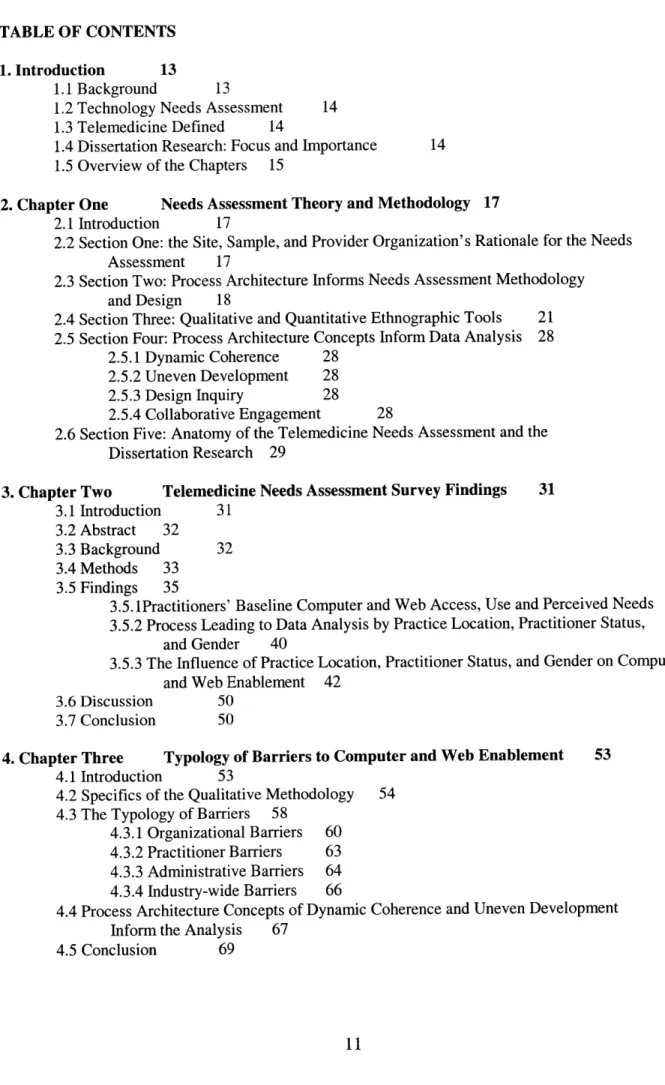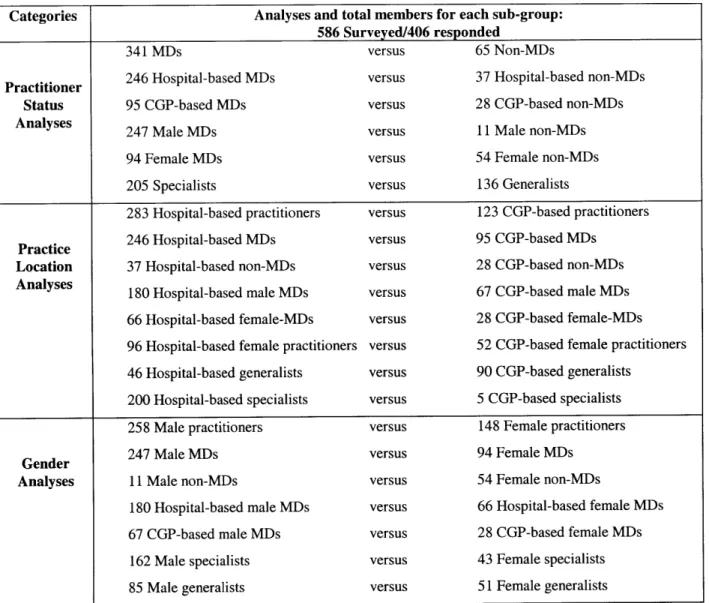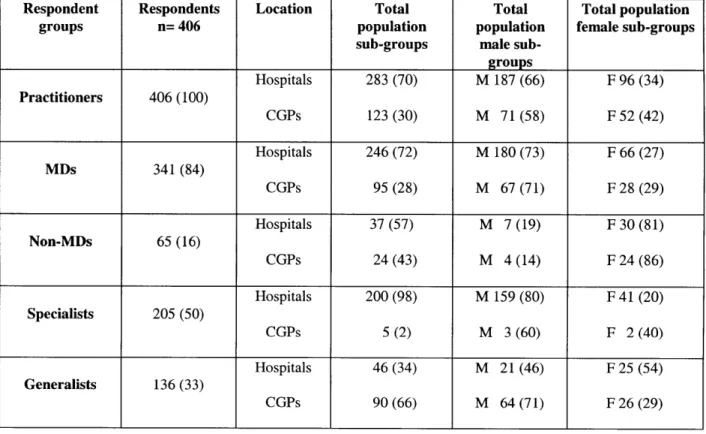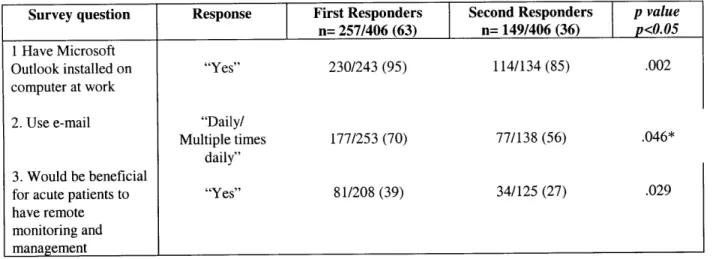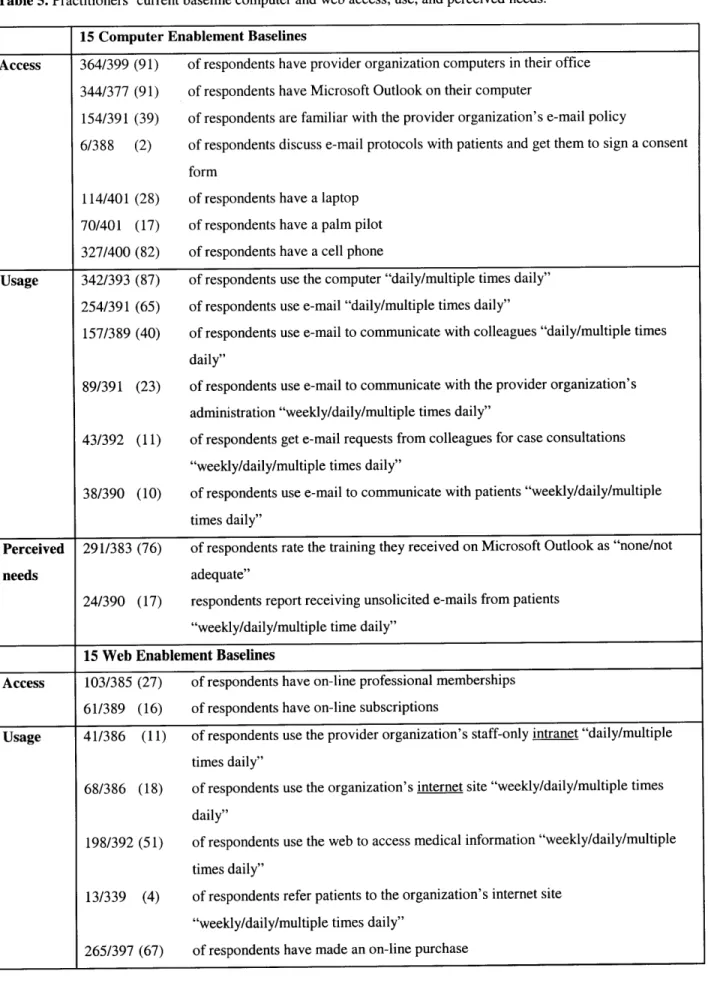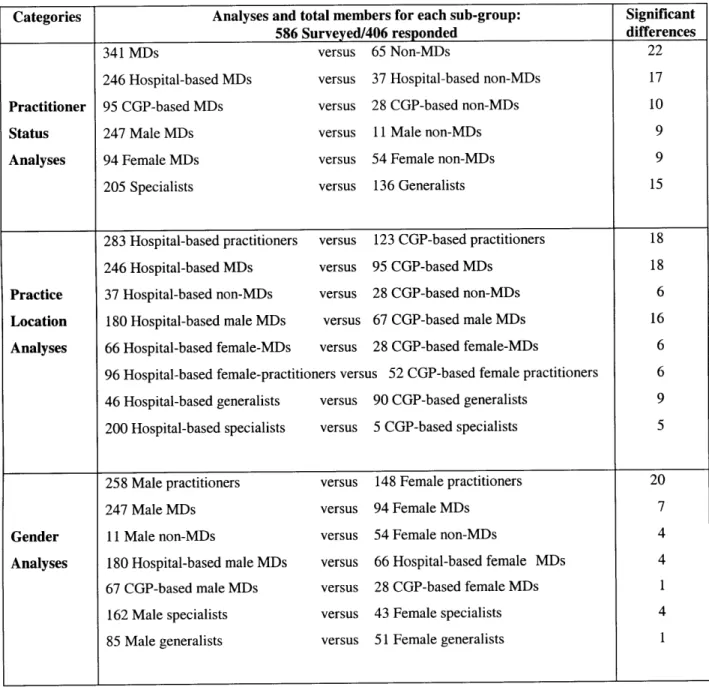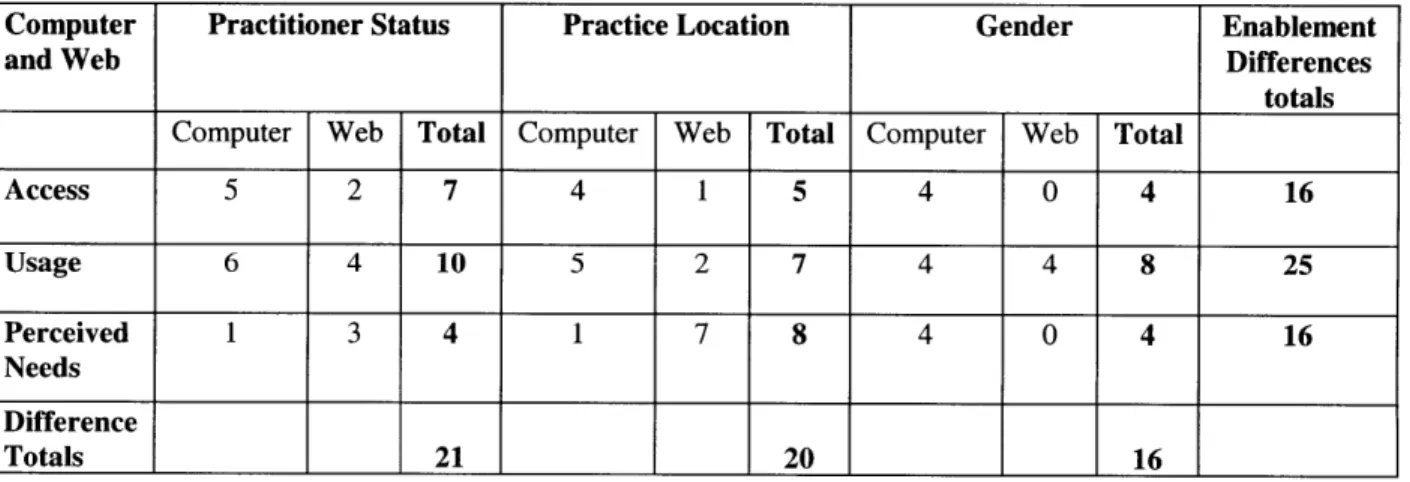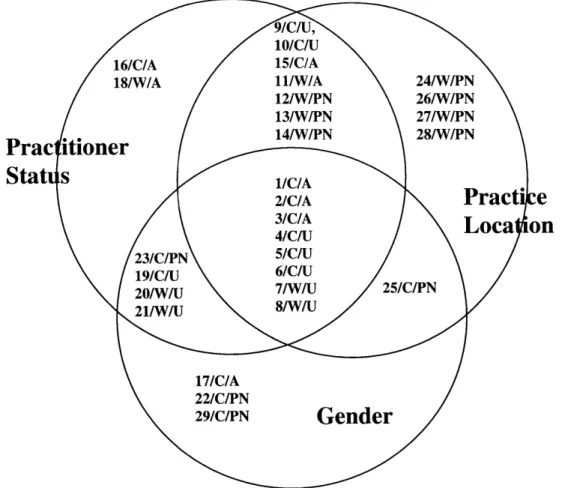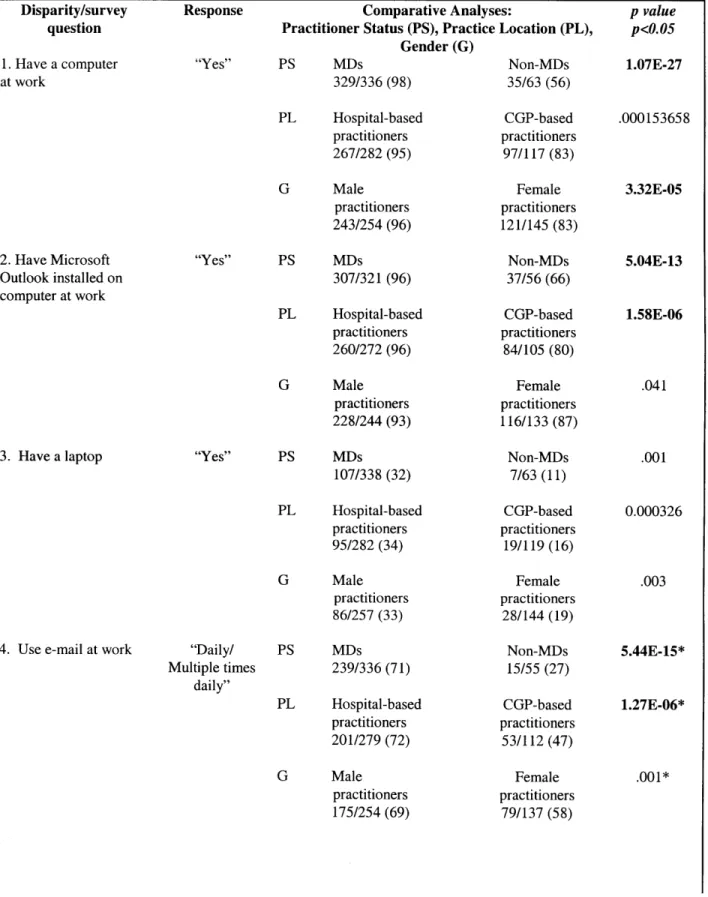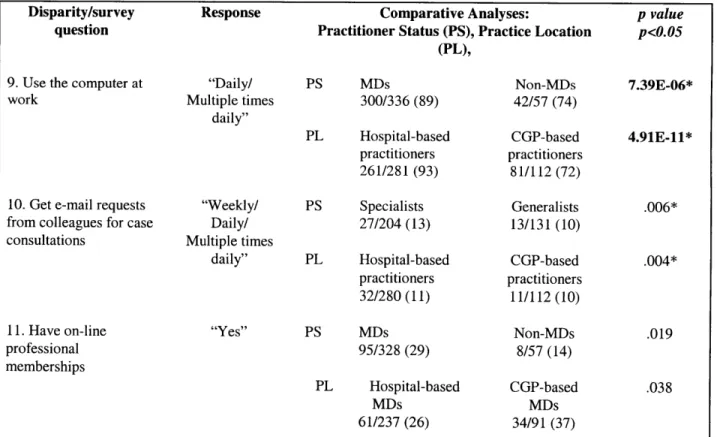Digital Diffusion in the Clinical Trenches: Findings From a Telemedicine Needs Assessment
By
Verld Margaret Harrop B.Sc. Occupational Therapy University of Toronto, 1975 S.MarchS. Design Technologies Massachusetts Institute of Technology, 1998
Submitted to the Department of Architecture
In Partial Fulfillment of the Requirements for the Degree of Doctorate of Philosophy in the field of Medical Informatics
at the
Massachusetts Institute of Technology
February 2002
ROTC
MASSACHUSETTS INSTITUTE OF TECHNOLOGYAPR 16 2002
LIBRARIES
copyright 2002 Verld M. Harrop. All rights reserved.
The author hereby grants to MIT permission to reproduce and to distribute publicly paper and electronic copies of this thesis document in whole or in part.
Signature of A uthor:... . . ... Department of Architecture
DeceTbeRf 8*,,2001 C ertified by:...
Williani L. Porter' Muriel Leventhal and Norman Leventhal Professor of Architecture and Planning Thesis Supervisor A ccep ted b y :...
Stanford 0. Anderson Chairman, Department Committee of Graduate Students
COMMITTEE MEMBERS William L. Porter Ph.D.
Muriel Leventhal and Norman Leventhal Professor of Architecture and Planning Massachusetts Institute of Technology
Thesis Supervisor
Isaac Kohane M.D. Ph.D.
Associate Professor of Pediatrics, Harvard Medical School
Director, Children's Hospital Informatics Program, Children's Hospital Research Affiliate MIT Laboratory for Computer Science
Michael J. Fischer Ph.D.
Professor of Anthropology and Science Technology Studies Science Technology and Society
Digital Diffusion in the Clinical Trenches: Findings From a Telemedicine Needs Assessment
By
Verld Margaret Harrop
Submitted to the Department of Architecture on December 18", 2002 in Partial Fulfillment of the requirements for the Degree of Doctorate of Philosophy
in the Field of Medical Informatics
ABSTRACT
Broadly stated, this dissertation focuses on how practitioners and provider organizations integrate the computer and web into healthcare delivery. The opportunity that afforded this research was a Telemedicine Needs Assessment commissioned by a Massachusetts-based provider organization, consisting of two hospitals and 29 community group practices (CGP).
The Telemedicine Needs Assessment incorporated qualitative and quantitative research programs to include: 1. cross-sectional, institution-wide, in-depth interviews; 2. participant observation at administrative and clinical day-to-day operations, and lastly, 3. a 68 item, closed-ended survey distributed to all 586 clinical practitioners to assess the access, use, and perceived needs of current computer, web, and telemedicine technologies.
Data from the survey, (72% response rate), established a computer and web enablement baseline against which the success, failure, or potential usefulness of any future medical informatics implementation would be evaluated. Findings included: 1. Computer and web enablement within the organization is not ubiquitous. Access is high, use is low; 2. Practitioner status, practice location, and gender affect enablement. Non-MDs, CGP-based practitioners, and female practitioners report lowest access and use. 3. No differences were reported specific to home access to computers and use of e-mail. 4. Hospital-based practitioners report greater access and use. CGP-based practitioners report greater perceived needs for teletechnologies. 5. Hospital-based and CGP-based male MDs emerge as the most polarized subgroups due to differences in computer and web use and perceived needs. 6. Female practitioners are more successful than male practitioners securing tech support at home and at work. 7. With regard to technology uptake, female MDs constitute a more homogeneous group than male MDs.
Also, four products emerged from the Telemedicine Needs Assessment: 1. a needs assessment theory and methodology derived from Process Architecture which promulgates that discussions specific to the end users' work must always be inextricably linked with their work practice; 2. a typology of barriers to the integration of computer and web-based technologies into healthcare delivery stratified by practitioner, administration, organization, and industry; 3. a framework which defines and integrates real and virtual healthcare delivery services, products, and technologies, and finally; 4. a systems-based model of clinical and telecommunications integrated delivery networks providing IS, IT, and administrative infrastructure support for the framework.
Thesis Supervisor: William L. Porter
ACKNOWLEDGEMENTS
I am deeply indebted to John Coller M.D., who managed the Telemedicine Needs Assessment database and tirelessly executed endless analyses on the Telemedicine Needs Assessment data. Simply stated, without his enthusiasm and dedication to the integration of computer and web technologies into medical practice, this research would not have taken place. For his innumerable contributions, encouragement, collaboration, and steadfast support, I am eternally grateful.
Similarly, I would like to thank the anonymous individuals of the equally anonymous provider organization where the dissertation fieldwork took place. It is my hope that their insights and generosity have been made manifest in the breadth and depth of this endeavor.
Also, I would like to thank Gigi Hirsch M.D (who coined the phrase, Digital Diffusion in the Clinical
Trenches), Geoff Evans Ph.D., and Stephen Porter M.D., all of whom graciously assisted in clarifying my
thoughts early on in the writing process.
Too, I would like to acknowledge the American Medical Informatics Association for allowing me to feature, in Chapter four, the substance of a paper titled, Virtual Healthcare Delivery: Defined, Modeled,
and Predictive Barriers to Implementation Identified, previously published in the AMIA Annual Meeting
Proceedings, 2001.
Finally, and with great warmth and fondness, I would like to thank: the Department of Architecture's Renee Caso who administered this interdisciplinary degree with admirable aplomb; my learned committee members, Isaac Kohane and Mike Fischer; and finally, my advisor Professor William L. Porter who kept a steady hand on the helm, and who, by example, indicated that he never expected less than the quest for perfection.
DEDICATION
This dissertation is dedicated to my family, to include: my father, Cedric Harrop, who encouraged me to pursue and then finish this degree; my mother, Laurel Harrop, who continues to provide an exemplary role model; my three siblings and four children who perceived my five years at MIT as a family undertaking; and last, and most importantly, my darling, patient editor-husband, Paul Steffler, whom I will now support so he can retire.
PREFACE
Before turning to the dissertation I want to review the somewhat unusual academic and research programs that sustained this interdisciplinary degree in the field of medical informatics.
Background
In 1996 I was admitted to the two-year Masters in Architectural Studies Program in Design Technologies, offered by the Department of Architecture, at MIT. After completing the masters, I embarked on a three-way interdisciplinary Ph.D. in Design Technologies; Science, Technology and Society; and Medical Informatics. Throughout my masters and Ph.D. programs at MIT, my academic advisor, in Design Technologies has been Professor William Porter, Muriel Leventhal and Norman Leventhal Professor of Architecture and Planning.
One of the applied research groups in Design Technologies was the Space Planning and Organization Research Group (SPORG) found at www.sporg.mit.edu. This committed group of researchers, which includes Turid Horgen, Mike Joroff, William Porter, and Donald Schon (deceased), together with their graduate students, studied how the workplace interacts with work practice. Grounded in Process
Architecture Theory and concepts, "researchers and stakeholders collaboratively rethink the dynamic
relationship between work processes and the spatial, technological, financial, and organizational environments within which they occur. Action Research serves as a means of intervention and organizational learning. This situated approach to workplace design is particularly suited to organizations in flux --- organizations undergoing: a merger, transformation in core business, or systems-wide changes to its telecommunications infrastructure." (Horgen, Joroff, Porter, & Schon, 1999) In other words, precisely the kind of work environments that medical infomaticians call home.
During my masters and Ph.D. programs I was a research assistant, first on a departmental project, subsequently with SPORG, and finally with an independent healthcare provider. Throughout, my research has focused on investigating how practitioners and provider organizations integrate the computer and web into healthcare delivery. A brief overview of the research undertaken over the past five years will establish the background I'll be drawing on throughout this document. As well, the overview will establish the scope of the graduate research undertaken, namely, that I experienced barriers to and motivators for integrating the computer and web into medical practice from both the bottom up, that is through the eyes of the individual practitioner, and from the top down, namely, from the provider organization's senior management perspective.
Graduate research program
From September 1996 -January 1997, my first term at MIT, I was a Research Assistant on a National Healthcare Project jointly undertaken by DARPA and the MIT Department of Architecture. The project focused on developing an interdisciplinary vision for national healthcare delivery. I also worked on two related pilot projects called The Operating Room of the Future and Hyacinth. The former investigates how successive and cumulative generations of technology are integrated into surgical environments; the latter was a framework for a web-based, patient-centered electronic medical record. While working on the National Healthcare Project I met the contact for my Ph.D. fieldwork, John A. Coller, MD, Assistant Clinical Professor of Surgery, Tufts University School of Medicine; Senior Staff Surgeon, Department of Colon and Rectal Surgery, Lahey Clinic.
January 1997 - August 1997 I became a SPORG research assistant to Turid Horgen, an MIT research associate working on the Opening up the Practice Project. This project was a subset of a larger project,
The Model Teaching Practice, supported by the PEW Trust Fund. The project was directed by Gordon
assistant, I carried out an in-depth ethnography of the practices of five primary care physicians in a staff-model health maintenance organization's internal medicine department. Data gathered during the fieldwork was analyzed for "Best of Breed" practices within that working environment. Results of the analysis were reflected back to the physicians who used the profiles to address systems problems and challenges posed by unproductive individual practice patterns. Subsequently, one of the five practitioners commissioned a case study.
September 1997 -May 1998, I carried out an extensive ethnography of a single primary care physician's practice and developed the findings into a case study. The case study, titled Primary Care Practice: By
Default or By Design, was submitted as my masters thesis in Design Technologies. In essence, this
successful primary care physician reported that he did not have enough support for his practice, and predicted that the incoming electronic medical record would decrease his efficiency. In order to understand why successful electronic medical record implementation is so elusive and to develop a better understanding of why failure is so common, a detailed understanding of the practitioner's work practice and practice environment is required. The four aims of the ethnography were to: 1. produce an in-depth profile of the functional status of the practitioners' primary care practice; 2. develop descriptive and analytical tools to determine the functional status of this primary care practice; 3. generate a theory relating the functional status of this primary care practice environment to the success or failure of electronic medical record implementation; and 4. identify a strategy for improving the functional status of primary care practice. Research results supported the hypothesis that the overall efficiency of a healthcare unit prior to implementation has direct bearing on the success or failure of electronic medical record implementation, and confirmed that the health maintenance organization's current infrastructure supported administrative practice not clinical practice.
September 1998 - March 1999, I became a Principal Researcher for a senior clinician in a provider organization. (This same provider organization was, some months later, to become the field site for my dissertation research.) In the capacity of Principal Researcher, I carried out an in-depth comparative analysis of three telemedicine programs. Initially, I developed an overview of five telemedicine programs in the greater Boston Area and one telemedicine program in Vermont. Then, I selected three programs and profiled them in depth. The three programs included: 1. Fletcher Allen Health Care in Vermont (a statewide primarily rural program networking physicians to physicians and physicians to specialists), 2. Partners' Telemedicine Program (a research program focused on delivering health care directly to patients in their homes), and finally, 3. New England Medical Center's Telemedicine Program (does pioneering work in international telemedicine). The purpose of the profiles was to assist the provider organization in determining its own strategic telemedicine trajectory, and the requisite technology and administrative planning required to implement it. This overview of the five telemedicine programs led the provider
organization to commission a formal Telemedicine Needs Assessment.
August 1999 - February 2000 I became senior consultant to the same provider organization's Telemedicine Task Force. Under the joint direction of a senior administrator and a senior medical staff member, I conducted a Telemedicine Needs Assessment for the provider organization's two hospitals and its 29 community group practices. Findings from in-depth cross-institutional interviews were distilled into a 68-question survey covering five domains: 1. computer access and use; 2. web access and use; 3. remote monitoring and management; 4. information, education, and training; and 5. technology and innovation. Of the 586 practitioners surveyed, 423 (72%) responded. The Telemedicine Needs Assessment constitutes my dissertation research and is the primary focus of this document.
Since February 2000, work related to my dissertation has included designing telehealth evaluation plans for the Canadian Federal Government's Canadian Health Infostructure Partnership Program (CHIPP) grant submissions. These extensive evaluation plans focus on electronic medical records and remote monitoring and management applications for acute and chronic disease patient populations. A sample
evaluation plan for a telemedicine program proposing remote monitoring and management of chronic heart failure patients is attached as Appendix A.
To summarize, the breadth and focus of these Masters and Ph.D. research programs has resulted in a grounded and scaleable understanding of the issues specific to integrating the computer and web into healthcare delivery. I have investigated technology-enablement issues from the individual practitioner's
perspective as well as from the viewpoint of the single provider organization. The masters program focused on the single practitioner charged with the task of integrating an electronic medical record into his work practice; the Ph.D. research program focused on how a single distributed provider organization evaluates a potential telemedicine implementation across its two hospitals and 29 community group practices.
Finally, this work has benefited from a complementary program of qualitative and quantitative methodologies. The Masters thesis was based on ethnographic fieldwork; the Ph.D. fieldwork leveraged that ethnographic tool set into designing and carrying out a survey. Findings from the survey led to thinking statistically about many of the same computer and web enablement issues that emerged from the Telemedicine Needs Assessment's qualitative data: namely, interviews, observation, and participant observation. Deploying qualitative and quantitative methodologies in concert allowed me to toggle back and forth between the perceived needs of the individual and the perceived needs of the provider organization.
Academic program
The underlying strength of this academic program is that it has been interdisciplinary. The Ph.D. program has three foci: Design Technologies with Professor William Porter; Science, Technology and Society with Professor Michael Fischer; and Medical Informatics with Dr. Isaac Kohane. Understanding how the computer and web are assimilated into healthcare delivery requires: a theory for understanding the relationship between work and work practice (SPORG's Process Architecture principals and concepts); qualitative and quantitative methodologies (the ethnography); and most importantly a subject, namely, computer and web enablement (the Telemedicine Needs Assessment). The combined application of these three disciplines has proved key to understanding the issues confronting computer and web enablement in the healthcare delivery sector.
Having established the thrust of my interdisciplinary program and identified the research projects specific to my Masters and Ph.D., the Introduction will now present the subject that connects them, namely, the technology needs assessment.
Excerpt from field notes based on an interview with a community group practice-based physician:
Dr. Snow loves to go and wander around Home Depot. His wife calls it "ToysRus for men." Dr. Snow says that the physicians' use of the computer is analogous to his Home Depot meanderings. "Sometimes you don't know what you want and have to see what there is before you can think of a use for it. Sometimes you have to be led."
Excerpt from life:
Having bagged my groceries, Mr. Belbin Senior, well into his seventies, walked me to my car. En route, I commented how glad I was to return home to St. John's where the quality of life is high. "It's the little things," I continued, "like having your groceries carried out to your car that make all the difference."
TABLE OF CONTENTS
1. Introduction 13
1.1 Background 13
1.2 Technology Needs Assessment 14 1.3 Telemedicine Defined 14
1.4 Dissertation Research: Focus and Importance 14 1.5 Overview of the Chapters 15
2. Chapter One Needs Assessment Theory and Methodology 17 2.1 Introduction 17
2.2 Section One: the Site, Sample, and Provider Organization's Rationale for the Needs Assessment 17
2.3 Section Two: Process Architecture Informs Needs Assessment Methodology and Design 18
2.4 Section Three: Qualitative and Quantitative Ethnographic Tools 21 2.5 Section Four: Process Architecture Concepts Inform Data Analysis 28
2.5.1 Dynamic Coherence 28 2.5.2 Uneven Development 28 2.5.3 Design Inquiry 28
2.5.4 Collaborative Engagement 28
2.6 Section Five: Anatomy of the Telemedicine Needs Assessment and the Dissertation Research 29
3. Chapter Two Telemedicine Needs Assessment Survey Findings 31 3.1 Introduction 31
3.2 Abstract 32
3.3 Background 32
3.4 Methods 33 3.5 Findings 35
3.5. 1Practitioners' Baseline Computer and Web Access, Use and Perceived Needs 38 3.5.2 Process Leading to Data Analysis by Practice Location, Practitioner Status,
and Gender 40
3.5.3 The Influence of Practice Location, Practitioner Status, and Gender on Computer and Web Enablement 42
3.6 Discussion 50
3.7 Conclusion 50
4. Chapter Three Typology of Barriers to Computer and Web Enablement 53 4.1 Introduction 53
4.2 Specifics of the Qualitative Methodology 54 4.3 The Typology of Barriers 58
4.3.1 Organizational Barriers 60 4.3.2 Practitioner Barriers 63 4.3.3 Administrative Barriers 64 4.3.4 Industry-wide Barriers 66
4.4 Process Architecture Concepts of Dynamic Coherence and Uneven Development Inform the Analysis 67
5. Chapter Four Framework Integrating Real and Virtual Healthcare Delivery 71 5.1 Introduction 71
5.2 The Challenge Facing Provider Organizations 72 5.3 Defining Real and Virtual Healthcare Delivery 72
5.4 Framework Integrating Real and Virtual Healthcare Delivery 72
5.5 The Framework Illustrated 73 5.6 The Framework Applied 75
5.7 The Framework Applied to Patient Care Plans 77
5.8 The Relationship Between Telemedicine Technologies and a Full Service Web Portal 77 5.8.1 The Full Service Web Portal 78
5.8.2 The Remote Monitoring and Management Technology 78
5.8.3 Clinical and Telecommunications Integrated Delivery Networks 78 5.8.4 Outsourcing 79
5.9 Modeling the Relationship Between the Telemedicine Technology and Web Portal 79 5.10 The Future of Integrated Real and Virtual Healthcare Delivery 81
6. Chapter Five Model for Systems-Based Healthcare Delivery 83 6.1 Introduction 83
6.2 Background 84
6.3 Methodology Review 85 6.4 Findings 86
6.4.1 Quantitative Findings Influencing the Design of the System-based Model 86 6.4.1.1 Practitioners' Perceived Need for Remote Monitoring
and Management Technologies 86
6.4.1.2 Practitioners' Receptiveness to a Call Center 88
6.4.2 Qualitative Findings Influencing the Design of the Systems-based Model 89 6.5 Rationale for the Systems-based Model 90
6.6 The Systems-based Model Supporting Integrated Real and Virtual Healthcare Delivery 91 6.7 The Systems-based Model Applied Across All Four Healthcare Delivery Quadrants 94
6.7.1 Case Study Quadrant One: Real Patient / Real Provider Organization 95 6.7.2 Case Study Quadrant Two: Virtual Patient / Real Provider Organization 96 6.7.3 Case Study Quadrant Three: Real Patient / Virtual Provider Organization 97 6.7.4 Case Study Quadrant Four: Virtual Patient / Virtual Provider Organization 98
6.8 Conclusion 99
7. Conclusion Directions For Further Research 101 7.1 Introduction 101
7.2 Work/Work Practice 101
7.3 A Baseline Computer and Web Enablement Tool 102
7.4 A Typology of Barriers to Ubiquitous Computer and Web Enablement 103 7.5 A Framework for Integrating Real and Virtual Healthcare Delivery 103
7.6 A Systems-based Model to Support Real and Virtual Healthcare Delivery 104
8. References 105
9. Appendices 111
A. CHIPP Chronic Heart Failure Detailed Telemedicine Evaluation Plan 111 B. Survey: Sample Form 131
C. Baseline Analysis 139
1. INTRODUCTION
1.1 Background
Broadly stated, this dissertation focuses on how practitioners and provider organizations integrate the computer and web into healthcare delivery. Specifically, this document reports qualitative and quantitative findings from a provider organization's Telemedicine Needs Assessment. The four products that emerged from the Telemedicine Needs Assessment and constitute the body of this dissertation are:
1. the development of a needs assessment theory and methodology;
2. a typology of barriers to the integration of computer and web-based technologies into healthcare delivery;
3. a framework which defines and integrates real and virtual healthcare delivery; and,
4. a model for systems-based clinical and telecommunications integrated delivery networks that supports real and virtual healthcare delivery.
However, prior to embarking on the dissertation proper, I want to establish what a technology needs
assessment is and, similarly, define telemedicine. Also, I want to address why I chose to focus my
dissertation research on a telemedicine needs assessment, and establish the potential contribution this work can make to the field of medical informatics. The introduction concludes with a thumbnail sketch of each chapter.
1.2 Technology needs assessment
Presently there is considerable pressure on practitioners to integrate communication and information technologies, such as computers, the web, on-line electronic medical records, decision support systems, evidence based protocols, telemedicine, and so on, into clinical practice. In order to respond to these pressures and expectations there must be a greater understanding of the computer and web access, use, and perceived needs of both practitioners and provider organizations. Although medical informatics researchers agree that the first step towards greater understanding is a thorough Needs Assessment (Aas, 1999; Anderson, Aydin, & Jay, 1994; Field, 1996; Friedman & Wyatt, 1997), there is confusion over what exactly a needs assessment is and consequently, how to carry one out.
It cannot be stated plainly or often enough how important it is for a provider organization to conduct a technology needs assessment. The purpose of even the most basic needs assessment is to establish the provider organization's computer and web access, use, and perceived needs baseline -- a baseline against which the success, failure, or potential usefulness of any future medical informatics implementation is evaluated. Ideally, a medical informatics implementation would proceed as follows: first, a provider organization would carry out a needs assessment. Second, the organization would implement the appropriate technology as determined by the needs assessment. Third, as previously noted, the success, failure, or potential usefulness of that implementation would be measured against the needs assessment baseline.
The greatest barrier to carrying out a technology needs assessment is the nature of the needs assessment itself. Unlike technology evaluations, supported by a substantive and growing body of medical informatics literature on how to conduct them (Bashshur, 1995; Field, 1996; Friedman & Wyatt, 1997; Heathfield, Pitty, & Hanka, 1998; Lewin Group, 2000; Perednia, 1995; Scott, Coates, & McCarthy, 1999), information on how to conduct a technology needs assessment remains unrealized. To elaborate, a technology evaluation is a post hoc process: dimensions to be measured are established a priori, for
example: decreased costs, increased production, or the removal of certain barriers. Furthermore, the evaluation tools themselves are becoming standardized (Cork, Detmer, & Friedman, 1998; Field, 1996; Nykanen et al., 1999; Talmon et al., 2000; VATAM, 2001). In contrast, the needs assessment, like the practice of medicine itself, is an art form. The needs assessment process is analogous to the practitioners' response to the patients' complaint, "I don't feel well!" Protocols and tools abound, but the art is to discern the patient's, or provider organization's true needs, and titrate the analytical framework, tools, and protocols accordingly. As in the case of a particularly challenging clinical case, new needs assessment tools and analytical frameworks may even be requisitioned on-the-fly. Clearly, the needs assessment modus operandi "I don't know what I'm looking for but I'll recognize it when I see it", is hard to justify on a grant proposal, rationalize to senior management, or delegate to others.
1.3 Telemedicine Defined
The Institute of Medicine defines telemedicine as "the use of digital information and communication
technologies to support and deliver healthcare when distance separates the participants". (Field, 1996).
This definition of telemedicine, which is synonymous with telehealth, encompasses the following teletechnologies: analogue, digital, and cellular telephones; faxes; video teleconferencing; radio; and all web based communications and services including, but not limited to: web portals, e-mail, nurse triage, expert advice, training and educational material, web-casts, on-line support groups, chat groups, list servs, interactive assessment tools, and so on. In other words this definition of telemedicine accommodates all forms of on-line healthcare delivery, and the requisite integrated clinical and telecommunications delivery networks to support them.
As these technologies continue to converge and become increasingly web-based, the now somewhat antiquated term telemedicine, may well give way to virtual or web-based healthcare delivery. Regardless of evolving nomenclature, the point is convergence. To elaborate, many of the challenges and issues that telemedicine has articulated and struggled with over the past 60 years, specific to healthcare delivery over phone lines, have direct relevance for effecting healthcare delivery over the web. In both instances, healthcare delivery over phone lines and healthcare delivery via the web conform to the Institute of Medicine's definition of telemedicine wherein "digital information and communication technologies are
used to support and deliver healthcare when distance separates the participants". Envisioning the
real-virtual healthcare continuum and its requisite clinical, administrative, and technological infrastructure --not to mention a business model -- poses a titanic challenge to the healthcare delivery sector.
1.4 Dissertation research: focus and importance
This challenge brings us back full circle to the dissertation research, which investigates how practitioners and provider organizations integrate the computer and web into real and virtual healthcare delivery. The research questions driving this dissertation mirror the scale and potential of the computer and web technologies themselves: "What would a big-picture integrating real and virtual healthcare delivery look
like? How can clinical and telecommunications integrated delivery networks be configured to support computer and web-based real and virtual healthcare delivery? How can we help practitioners and provider organizations integrate the computer and web into clinical practice? What are the barriers to integration? What are the steps that a provider organization can take towards computer and web enablement", and so on? These are the very questions that directed the research program reported in this
document.
The value of this research to fellow medical informatics researchers is that answers to these research questions are generalizable. Moreover, the findings are of particular interest to provider organizations and researchers alike, because of the setting where this research took place -- a provider organization consisting of two hospitals and twenty-nine community group practices distributed throughout the State
of Massachusetts. In comparison, prior research on practitioners' computer and web enablement has been carried out, for the large part, within academic settings (Cook, Hartman, & Russell, 1998; Jerant & Lloyd, 2000; Tierney, Overhage, McDonald, & Wolinsky, 1994; Weiner et al., 1999), or across professional organizations (Latcher, Nelson, Bylsma, & Spena, 2000). Access to a single, distributed, provider organization, and for such an extended period of time, is highly unusual. In a nutshell, this dissertation research provides a robust snapshot of "Digital Diffusion in the Clinical Trenches."
1.5 Overview of the chapters
To conclude, chapter One presents a Needs Assessment Theory derived from Process Architecture and provides a detailed account of the needs assessment methodology that has been developed. Chapter Two presents the quantitative data, namely, findings from the Telemedicine Needs Assessment survey. Chapter Three presents the qualitative data resulting from the interviews, observation, and participant observation. In effect, Chapter Three proposes a typology of barriers to computer and web enablement. Chapter Four offers an emergent framework integrating real and virtual healthcare delivery. Chapter Five proposes a systems-based telemedicine model to provide the administrative, clinical, technical, and telecommunications support required by the framework for real and virtual healthcare delivery. The document concludes by proposing possible next steps for fellow researchers.
Please note that throughout the document every attempt has been made to ensure the anonymity of both the individuals and provider organization. Names, when used, are factitious
2. NEEDS ASSESSMENT THEORY AND METHODOLOGY 2.1 Introduction
This dissertation investigates how practitioners and provider organizations integrate the computer and web into healthcare delivery. The opportunity that afforded this research was a Telemedicine Needs Assessment commissioned by a Massachusetts-based provider organization. As the Telemedicine Needs Assessment process unfolded, a needs assessment theory and a needs assessment methodology emerged. What distinguishes the needs assessment theory and methodology presented here are their generalizability. To elaborate, the needs assessment theory and methodology are not specific to telemedicine but rather can be adapted and applied to any medical informatics technology under consideration for implementation.
Material in this chapter is presented in five sections. Section One introduces the site, sample, and the provider organization's rationale for commissioning a Telemedicine Needs Assessment. Section Two presents Process Architecture's espoused theory, namely, that work cannot be conceived of and discussed separate and apart from work practice. The section then establishes how the theory was assimilated into the combined qualitative and quantitative methodological research design. Section Three details the qualitative and quantitative ethnographic tools used. Section Four identifies process architecture concepts, namely; dynamic coherence, uneven development, design inquiry, and finally, collaborative engagement, all of which can potentially inform the needs assessment tool development and data analysis. Having established the site, sample, and tools, Section Five differentiates between the Telemedicine Needs Assessment that culminated in a report for the client, and my dissertation research resulting in this document. This chapter lays the groundwork for chapters, Two and Three. Chapter Two offers the quantitative data from the Telemedicine Needs Assessment, namely, findings from the survey. Chapter Three presents the qualitative data resulting from the interviews, observation, and participant observation.
2.2 Section One: the site, sample, and provider organization's rationale for the needs assessment
A clinician and champion of telemedicine, whom I met back in 1996 while working on the National Healthcare Project during my first term at MIT, facilitated my entry to the fieldwork site. This senior clinician commissioned PHASE I: A Profile of Four Telemedicine Programs, January - June 1999. Subsequently, the same clinician, together with the provider organization's senior administration, jointly commissioned PHASE II: A Telemedicine Needs Assessment, August 1999 - February 2000. This dissertation document focuses primarily on the PHASE II Telemedicine Needs Assessment.
The provider organization, where both the PHASE I Profile of Four Telemedicine Programs and the PHASE II Telemedicine Needs Assessment both took place, consists of two hospitals and 29 community group practices located throughout Massachusetts. This physician-run organization serves 350,000 active patients, and processes 1,000,000 patient visits per year. Presently, the provider organization attracts 120 new patients per day. The two hospitals are established tertiary care facilities located 18 kilometers from each other. The 29 community group practices range from two to fifteen person practices and are distributed across the state. The provider organization purchased the majority of community group practices four years earlier (1996), in the wake of managed care; the rationale being to secure market share. At the time of this study, the community group practices' primary concern was that their autonomy and independence not be subsumed by the provider organization, perceived to be resident in the two hospitals. The hospitals' primary concern was to "make good" on their investment in buying the community group practices by receiving increased specialty referrals from the community group practices' practitioners.
The provider organization's reasons for commissioning the Telemedicine Needs Assessment were fourfold. The provider organization wanted to:
1. establish its practitioners' computer and web access, use, and perceived needs baseline -- a baseline against which the success, failure, or potential usefulness of any future medical informatics implementation would be evaluated;
2. identify the factors influencing practitioners' computer and web enablement. Establishing these factors would assist the provider organization in determining and aligning its strategic clinical and administrative business trajectories with its information systems and information technology needs;
3. project realistic timelines for moving towards a paperless environment and an electronic medical record -- goals requiring ubiquitous computer and web enablement; and finally,
4. determine if telemedicine, particularly the web-based remote monitoring and management of acute and chronic disease populations with call-center support, would complement the organization's extensive in-patient and out-in-patient case management program.
It would be misleading to infer that, from the onset, the provider organization knew exactly why it was commissioning the telemedicine needs assessment and the specific aims it expected the needs assessment to address. In fact, at the onset, only the goal was clear -- the provider organization wanted to commission a telemedicine needs assessment. In contrast, the four aims of the Telemedicine Needs Assessment, listed above, emerged over time and out of the needs assessment process. This provider organization's quandary, knowing that they needed something but not knowing exactly what that something was or how to achieve it, is the norm and underscores the purpose of a needs assessment.
The purpose of any medical informatics needs assessment is to help the client articulate, from multiple stakeholders' perspectives, precisely what the clients' needs are, then assist the client in determining the most appropriate means of addressing those needs. As noted earlier in the preceding chapter, the most important product resulting from a thorough needs assessment is the establishment of a clients' technology access, use, and perceived needs baseline -- a baseline against which the success, failure, or potential usefulness of any future medical informatics implementation is evaluated. Boldly stated, without the baseline, an evaluation of a medical informatics technology is meaningless, and furthermore, strategic clinical, administrative, and technological trajectories specific to medical informatics implementations are unfounded. In other words, a provider organization must have a needs assessment baseline in order to say, with authority, this is where the organization is right now, these are realistic goals, and this is how we are going to achieve them.
2.3 Section Two: Process Architecture informs needs assessment methodology and design In recent years, researchers have used established theories from other disciplines to better understand and predict the role that telemedicine plays in healthcare delivery. Researchers have deployed Systems
Dynamic Theory used to describe the relationship between quality of care, accessibility, and cost
effectiveness (Valero et al., 2001); the Theory of Reasoned Action, a predictive model to predict practitioners' attitudes towards implementation (Araugo, Paiva, Jesuino, & Magallaes, 2000); The Theory
of Planned Behavior to investigate technology acceptance by physicians in practice (Hu & Chau, 1999); the Theory of Knowledge Barriers, to explain why diffusion remains low (Tanriverdi & Iacono, 1999);
and finally, a familiar face to Process Architects, Innovation and Network Theory to develop hypothesis about conditions that will hinder or facilitate sustained use of telemedicine (Wells & Lemak, 1996). Although the deployment of these theories is valuable, none of the above, individually, offer a seminal guiding construct or grounding principal, as it were, for the field of medical informatics.
There are, however, two research groups that have made important contributions to our knowledge about
use specific to telemedicine. The first research group uses Gidden's Structuration Theory to develop a
theory of use versus physicians' perceived needs for communication and expert advice systems (Lehoux, Sciotte & Lacroix, 1999). The second body of work proposes a methodology for developing and implementing Best Practices, in telehealth and telemedicine (Picot, 1999). Although both of these parties promote applied theories, which sustain and in effect underwrite development within the field of medical informatics, I propose that medical infomaticians would be well served to investigate a theory or set of professional constructs that guide and inform on-going processes rather than after-the-fact analysis. Simply stated, technology needs assessments are a series of overlapping processes, and as such need a guiding theory and constructs that will inform these processes.
A thorough needs assessment is, in effect, an ethnography. An ethnography, by definition, refers to the collection of data, quantitative and or qualitative, that describe a culture (Bernard, 1995). The ethnography presented here, albeit atypical due to the emphasis on analysis rather than description, is of a provider organization and its culture of computer and web enablement. Ethnography is a longstanding research methodology in the social sciences and has much to offer the field of medical informatics. This is particularly true when the ethnography is informed by Process Architecture constructs and processes. Process Architecture, developed by the SPORG Research Group at MIT in the Department of Architecture's Design Technology Division, maintains that "work cannot be studied or understood separate and apart from work practice (Horgen, et al., 1998)."
This seminal Process Architecture belief, that "work cannot be conceived of and discussed separate and apart from work practice" underscores medical informatics greatest vulnerability: our downfall, as researchers and developers, has been conceptualizing work separate and apart from work practice. The past quarter of a century bears witness to medical informatics technologies and software products, decision support systems and electronic medical records, to name two, that work in the computer lab but struggle or even fail repeatedly in the workplace. The needs assessment, I propose, is the first step in ensuring that work and work practice remain inextricably linked. In other words, the relationships between work and work practice cited in the needs assessment set the groundwork for maintaining that work/work practice relationship throughout iterative cycles of a medical informatics tool's design and development, implementation, and evaluation.
Maintaining the link between work and work practice requires a combined qualitative and quantitative research program. Throughout this needs assessment, the qualitative methodology included cross-sectional, institution-wide, in-depth interviews, and participant observation at administrative and clinical meetings and during day-to-day operations at the provider organization. The quantitative research program focused on the telemedicine needs assessment survey distributed to all clinical practitioners to assess current computer, web, and telemedicine technology usage and needs.
There are direct parallels between work and work practice and quantitative and qualitative research methodologies. When we talk about work we are using an abstract term, just as quantitative data, numbers, are an abstraction. In contrast, when we talk about work practice and qualitative data, both are specific to being there. Although the differences between abstractions and being rooted in the reality are interesting to explore, what is of particular importance to researchers and developers here are the advantages of deploying complementary quantitative and qualitative research programs when examining work/work practice.
The advantages of deploying complementary quantitative and qualitative research programs when investigating work/work practice are threefold:
1. Complementary qualitative and quantitative methodologies inform one another. For example, during the interview process, numerous practitioners voiced negative feedback about the provider organization's public internet site for health information: "It's useless. It doesn't have anything worthwhile on it. " This qualitative data-point subsequently informed the design of the following survey questions: A. "Do you refer patients to the provider organization web site for health information?" and B. "Name the web sites for medical information that you recommend to your patients." Survey respondents' answers to these questions determined that only 4% of practitioners referred patients to the provider organization's web site for medical information, and furthermore, that the majority of practitioners referred patients to their specialty website for medical information. Based on these survey findings, the obvious follow up interview questions are, "Why do you refer patients to your specialty site for medical information?" and "Describe the kind of site you'd like to refer your patients to for medical information." -- and the cycle of one methodology informing and building on the other continues.
2. Complementary qualitative and quantitative methodologies allow the researcher to generalize from the particular. For example, the inadequacies of the provider organization's intranet, from the practitioners' perspective, emerged during interviews with individuals: the prevalence of those individual practitioners' views was determined by the survey.
3. Finally, and as importantly, a combined research methodology for needs assessments allows researchers to quantify a provider organizations' computer and web enablement baseline. Although comparative descriptions of qualitative data are useful, provider organizations are acculturated to comparisons using quantitative data. Provider organizations want to be able to say, for example, in 2000, 75% of the provider organization's practitioner population stated that training on the institution's e-mail handler was "inadequate or non-existent"; by 2001, x% reported the same finding, and so on.
Before concluding this section, I want to identify a contemporary principle driving architecture and propose a principle to guide developments within medical informatics. Researchers and developers have produced a growing body of literature confirming that the medical informatics tools we create will only be used if those tools make practitioners' work practice more efficient (Tang & Patel, 1994). Unfortunately, medical informatics technologies can, depending on work practice, make a practitioner less efficient. A case in point is the practitioner I observed during his three and a half hour office session. My observations of the practitioner's work practice confirmed that prior to the electronic medical record implementation there was already a lack of fit between the practitioner's idiosyncratic work practice needs and the existing computer interface: the log-on process took too long and he couldn't access the other practitioners' appointment schedules. The practitioner predicted that the incoming electronic medical record would make his work practice even less efficient on two additional accounts. At least initially, there was some question of how accessible the electronic medical record would be from home, at night, and on the weekends -- times when he presently logs on from home to catch up on paper work. Also, the incoming electronic medical record will require him to access the computer more often than he is presently doing.
The following excerpt from my observation notes substantiates his frustration and illustrates how the lack of fit between his work practice needs and the current technology directly influences his efficiency. "The
next challenge is a walk-in patient who wants to be seen but Dr. Harris has a full schedule. He points out the limitations of the current computer interface, in that every time he wants to use the machine he has to go through the time-consuming process of logging on. He repeats this time-consuming security measure
an estimated 15 times a day. Once logged on, there is no way for him to query if there is a practitioner in internal medicine A or B who has an appointment opening and can see the patient."
Without question, the more efficient a technology potentially makes us, the more predisposed we are to using it. Prosaic as the reality is, medical informatics technologies are subject to these same laws. In Architecture an oft quoted touchstone, erroneously attributed to architect Louis Sullivan is: 'formfollows
function" (Van Zanten, 2000): a comparable principle for those of us working in medical informatics might be "fit follows efficiency".
To summarize, it is imperative that medical infomaticians assimilate and internalize the Process Architecture belief that work cannot be conceptualized separate and apart from work practice. Furthermore, work/work practice is best understood using a combined qualitative and quantitative methodology. Finally, the successful uptake of a medical informatics technology depends on its ability to increase the end users' efficiency, and efficiency is increased in direct proportion to the fit between the medical informatics technology and work practice.
Having described how Process Architecture beliefs can inform a needs assessment, and having underscored the importance of a combined qualitative and quantitative methodology, I will now describe the qualitative and quantitative ethnographic tools used to operationalize the needs assessment.
2.4 Section Three: qualitative and quantitative ethnographic tools
The ethnographic tools used throughout included: interviews, observation, participant observation, and a survey. There was also a crucial ongoing relationship with a key informant. This section provides background information on these tools and demonstrates how they are used to gather data. The specifics of how these quantitative and qualitative tools were deployed during the Telemedicine Needs Assessment, the data they generated, what analysis revealed, the implications of the findings, and last but not least, the tools' inevitable shortcomings, are detailed in Chapters Two and Three.
2.4.1 Interviews
The interviews were unstructured and lasted, on average, from forty-five minutes to an hour and a half. Following the methodology described by Weiss (1994) in his Book "Learning From Strangers: The Art and Method of Qualitative Interview Studies", the sessions were conducted as follows: I introduced myself as the consultant for the Telemedicine Task Force and stated that I was also a Ph.D. candidate pursuing an interdisciplinary degree in the field of medical informatics at MIT. I then went on to note that my dissertation research focused on how practitioners integrated the computer and web into medical practice and that the research that I was conducting for the Telemedicine Needs Assessment Task Force might also form part of my dissertation. It is important to note that permission to use the Telemedicine Needs Assessment data for my dissertation was included in my contract as senior telemedicine consultant to the provider organization's Telemedicine Task Force.
Having introduced myself, I then initiated the interview by asking the interviewee to tell me about their own computer and web use and experiences at work; what worked well and more importantly what didn't; what made their work practice more efficient; what they found particularly frustrating; what they would like to see in the future; and finally, what computer and web technologies, if any, would really address their needs. Almost without exception this opened the floodgates. The predominant interview technique was silent probing. At the end of the interview, if appropriate, I asked if there was someone in particular that I should talk to or a particular medical event that I should observe. In some cases, if access looked like a potential barrier, I would ask the interviewee to make a telephone call or e-mail introduction on my behalf.
Interestingly, practitioners, and in particular the community group practice practitioners, were highly averse, and in some instances overtly hostile, to having interviews taped. Reasons for the resistance to being taped coalesced into three categories: practitioners were sensitized to litigation; respondents did not want the information shared with administration; and finally, community group practice-based practitioners felt certain information would jeopardize their relationship with the hospitals. Consequently, I took extensive notes throughout the interview and augmented those notes immediately following the interview session. If a particularly sensitive issue was covered, then a copy of my interview notes was delivered to the interviewee who was encouraged to review them and augment, revise, or correct the content. Anonymity was guaranteed.
Immediately following an interview I organized the subject matter that the interviewee covered under topic headings, for example, "e-mail", "referral patterns ", "tech support", and so on. Topics or issues were flagged if they were what I call hot buttons -- issues or topics that were likely to strike the resonant
chord with fellow practitioners. These hot buttons were subsequently distilled into potential survey
questions or tagged as issues to raise in follow-up or future interviews. Data was also flagged if it related to barriers to the integration of the computer and web into medical practice. The typology of these barriers is the subject of Chapter Three. Following in Figure 1, is an excerpt from an interview with a community group practice practitioner. The hot buttons are underlined. Text that relates to the typology of barriers to computer and web enablement has been bolded.
Figure 1: Excerpts from an interview with Dr. Snow, a community group practice practitioner
e Colleagueship cited as fundamental building block: The Wintergreen Internal Medical Associates
Community group practice is located approximately 70 miles from the primary tertiary care hospital. Presently, the Wintergreen physicians can't put faces to those hospital-based physician's names. Dr. Snow maintains that video teleconferencing for grand rounds and educational sessions would impact directly on referral patterns and cement the practice's relationship with the provider organization: "It would make a huge difference to call a guy and see his face"...." Sometimes it is
the singer and not the song that saves the day". Dr. Snow wants to attend grand rounds, medical
meetings, and lectures in cyberspace. Dr. Snow maintains that if you can make the community group practice practitioners feel part of the provider organization community, then everything else will fall into place. The community group practice practitioners are aware that the provider organization wants them to send all their interesting patients to them but the reality is that collegiality is the drawing card for doing so.
* Existing referral patterns: Convenience is a big issue for patients because the provider
organization's primary hospital is 140 miles round trip. Even more important are the relationships that the community group practice physicians already have established with their colleagues at the local hospital. These relationships are convenient and historical. If Dr. Snow has a dermatology consult that he is curious about, then he can just pick up the phone and his colleagues will get right back to him. Feedback is instantaneous. "Collegiality is an instant
consult." Presently, this level of service is also provided in radiology and orthopedics.
e Existing tech support: Dr. Snow says that the tech support at the local hospital (where he is Medical Director) is excellent. "They will come to your office and even your home to get
physicians up and running." Presently, the Wintergreen practice is not on the provider
* E-mail: The provider organization originally used Pegasus because it was free. "Microsoft Outlook which is replacing Pegasus is not intuitive like the MacIntosh interface. This is a problem. The e-mail should also be secure. If it is easy to use it will hook people.
2.4.2 Observation and participant observation
In the case of observation and participant observation, the tool to be deployed is the researcher. Bernard
(1995) says "participant observation involves establishing rapport in a new community; learning to act so that people go about their business as usual when you show up; and removing yourself every day from cultural immersion so that you can intellectualize what you're learned, put it in perspective, and write about it convincingly. ". The distinction between observation and participant observation is debatable. I've
differentiated between the two because, on the one hand, certain tasks that I participated in were clearly related to my role as a telemedicine consultant to the Telemedicine Task Force. On the other hand, a significant amount of the field research had less to do with the report for the Task Force and more to do with the events I was observing specific to the dissertation.
The modus operandi that the researcher brings to these tasks, of observation and participant observation, is of utmost importance. Once again, there is a mindset used in the practice of Process Architecture that is useful in our work as medical informatics researchers and developers. In Process Architecture, the modus
operandi is that of the reflective practitioner. The reflective practitioner is a term coined by the late
Donald Schun, Ford Professor Emeritus, and a Senior Lecturer in the Department of Urban Studies and Planning at MIT. In his seminal text, The Reflective Practitioner, Schon (1987) describes the
knowing-in-action that practitioners bring to their everyday lives. Inherent in knowing-in-knowing-in-action is the iterative
process of reflection-in-action. In other words, "skilled practitioners often think about what they are doing while doing it in situations of uncertainty, uniqueness, and conflict." This reflective practitioner skill set is analogous to the process researchers goes through when they discover themselves stepping back from a situation and asking, What's wrong with this picture?. To elaborate, the researcher experiences a level of cognitive dissonance between the subject's espoused theory (what they are really doing) versus the theory in action (what they say they're doing). For example, the provider organization espoused that they were investigating telemedicine as a means of effecting cost savings and improving quality of care. However, as negotiations with the telemedicine progressed it became apparent that the provider organization was concerned that telemedicine's potential for savings would negatively impact the provider organization's ability to generate revenue.
"It is this capability for reflecting-on-knowing and reflecting-in-action, that allows practitioners to
formulate and criticize their action strategies and their ways of framing problems and roles (Argyris & Sch~n, 1995)." As seen in Figures 2 and 3, this modus operandi, or mindset, of the reflective practitioner is integral to the path of a successful ethnographer engaged in observation and participant observation. Once again, the mindset and methodology complement one another. Moreover, together they reinforce the conceptualization of work with work practice, and provide a process for ferreting out discrepancies between the two.
Following in Figure 2 is an excerpt from a participant observation session. It is an excerpt from my notes describing a presentation that the telemedicine champion gave to the community group practice representatives at one of the representatives' monthly administrative meetings. The purpose of the presentation was to provide an overview of telemedicine technology and its potential applications within the provider organization. Additionally, this was the occasion were I was introduced to the community group practice community as the consultant/Ph.D. student from MIT, who would be contacting the community group practice practitioners on behalf of the Telemedicine Task Force. The text in Figure 2 captures what Geertz (1973) refers to as a "thick description" of the event (Geertz, 1973).
Figure 2 Participant observation notes: the telemedicine champion introduces telemedicine to the community group practice practitioners
The Chair opened the meeting by polling how many directors had read the meeting's minutes and agenda on their e-mail. Of the 30 persons present, only one had. In fact, the thirty-something female physician sitting next to me confided that she didn't have e-mail. The chair then went on to emphasize that the directors themselves had decided that e-mail usage was a priority for the group and therefore they had better get with it. The Chair then turned the meeting over to the telemedicine champion who presented an overview of telemedicine technologies and their possible applications within the provider organization. Following a telemedicine technology overview, the potential involvement of the affiliates was broken down into two phases. PHASE I entailed a store and forward asynchronous technology allowing the remote physician to send a digital image as an e-mail attachment to the specialist for consultation. PHASE II entailed videoconferencing for consultation, education, and administrative purposes. Unlike the former, the latter requires a significant investment both in terms of technological, and administrative infrastructure. The purpose of the Telemedicine presentation was to actively encourage community practice physicians to test drive the former, the relatively simple store and forward e-mail attachment technology.
When the presentation concluded, the Chair thanked the presenter, then pointed out to the attendees that patients were turning to alternative medicine because they were not getting the caring, human touch in medicine, and therefore one should be very cautious about incorporating these technologies into practice.
The detailed description of the event and concomitant reflective practitioner process produces data that, when analyzed, identifies the tensions between the community group practices and the hospitals. Identifying these tensions underscored the need for, and subsequent decision to carry out, an in-depth Location Analysis of the survey data. The purpose of the Location Analysis was to determine differences in computer and web access, use, and perceived needs between hospital-based and community group practice-based practitioners.
As in the case of the interviews, following each session of participant observation, a more formal account of the session is distilled from "scratch notes" (notes taken during the session). Once again, in the process of analyzing the data hot buttons are flagged and contributions to my growing typology of barriers to computer and web enablement are noted in bold. Over the course of the Telemedicine Needs Assessment and dissertation research, data from observation, participant observation sessions, and interviews were analyzed and reanalyzed in light of emergent themes.
The observation session presented in Figure 3 is an excerpt from fieldwork conducted during my masters program. The observation session profiles an internist's practice patterns during a typical three and a half hour office clinic. I've chosen to augment my dissertation research with this sample for two reasons. The first being, I want to balance the preceding qualitative data at the administrative provider organization level, with qualitative data collected at the level of the individual clinician. Second, I want to demonstrate the level of granularity, to mean the level of detail that must be observed in order to think meaningfully about aligning a medical informatics technology with work/work practice. The data captured and reported in Figure 3 exemplifies the relationship between work and work practice. Moreover, this example underscores the profound challenge posed when aligning a medical informatics technology, in this case an incoming electronic medical record, with a clinical practitioners' perceived work practice needs. Once again the sample is descriptive in that it recounts what I'm observing, and at the same time the sample is
